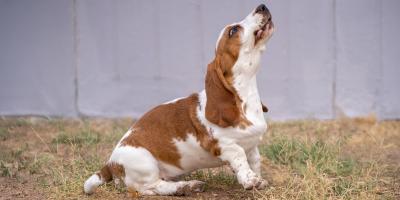What Types of Dog Growl Mean


Many people believe that dogs growl due to aggression, however there are so many different reasons why your dog may be growling. Read our guide to find out the different types of dog growl and what they mean.
Dogs try to communicate with people in different ways, one of which is growling. As pet owners, we often assume that dog growling is a signal of displeasure or aggression, but it isn’t always that simple. There are a range of things that your dog may be trying to convey when they make these growling noises, and if you listen closely, they may not all sound exactly the same.
Read on for more information on the different types of dog growl and what they may be trying to tell you when they do so.
Why Do Dogs Growl?
Dog growling is simply a method of communication – it’s your dog trying to tell you something. Dogs growl to communicate lots of different things, from fear and aggression to encouraging play. That’s why you need to understand the types of dog growl to interpret what the sound means.
Always pay attention to the situation that your dog is in when they growl. You may find that your dog makes different types of growling sounds in different situations, and learning to recognize the circumstance of each dog growl will help you to identify what it is your dog is trying to say. Those sounds may seem similar to us, but it’s all about context! Where one growl may be saying: “I feel threatened,” another could be saying: “I’m having fun!”
Dog Growling When Playing
If you’re wondering, Why does my dog growl when playing?, you’re not alone! It can seem strange to us when dogs do this – why would they suddenly make a sound of aggression when you’re having fun together? The simple answer is they aren’t!
This type of dog growling indicates that your pet is having fun; your dog might even be trying to tell you that they want to keep on playing! Although it’s hard for the human ear to pick up on subtle differences in dog growling, play growls can be distinguished from other more aggressive types of growl.
Although every dog is different and has their own vocal range and individual ‘voice’, in general dog play growls will sound higher pitched than other kinds of growling. They will also often be shorter and may be accompanied by body language like bounding motions, or your dog bending down onto their front legs, or raising their rear-end in the air (play bow). Many dogs growl during tugging games that they enjoy.
Don’t be intimidated if a dog growls during play with either a person or with another dog. Do keep an eye on the situation in case it escalates, but usually growling during play indicates that a dog is just having fun.
Aggressive Dog Growling
Aggression is about wanting to end a situation or get space or distance from someone (canine, human, any other species or perceived threat), therefore aggressive dog growling is simply one of many communications a dog can give to say, “give me space, back off, stop.”
If you’re not sure whether a growl is aggressive or not, or if you think it might be – stop what you’re doing and back off, or remove your dog from the situation, as appropriate.
How Do I Know if My Dog is Growling Aggressively?
Growls designed to make bad things stop or go away may be deep, may involve bared teeth, and may be low and rumbling but pitch and volume depend on the size and breed of the dog and will vary from dog to dog (much like our own voices, shouts, cries, whispers etc. vary from person to person).
Take context and body language into account, don’t just consider the growl. A stiff body, a tail held high, maybe wagging but in a tense manner, wide eyes, ears back, lips pulled back, teeth bared – all these add up to a dog who really wants this situation to stop, now!
Some dogs will not show all these signs though. A very small dog with hairy floppy ears may produce a higher-pitched growl, you may not see the ears back as they won’t go so far back as pricked ears, the tail may be too hairy to see the movement properly, or the muzzle may have such long hair you can’t see the lips drawn back or the bared teeth.
Others may have skipped stages of communication – some will escalate from a soft growl to a louder growl to a snarl, then air snaps and finally a bite. Some will go straight to the bite, depending on both genetics and prior learning. Others who have been punished for growling in the past might also go straight to a nip or bite.
Don’t ignore warning growls: pay attention to whatever it is that is causing your dog to feel threatened or afraid and try to remove the cause of the issue. Your dog doesn’t want to escalate the situation, they are simply trying to communicate!
Never tell a dog off for this kind of growling. It is far better you get a warning than the dog going straight to a bite – which can easily happen if a dog has been punished for growling in the past.
Pleasure Growling
Although dogs don’t exactly make audible sounds in the same way that cats purr when they are experience pleasure, you may have noticed your pet make a strange sort of purr-come-growl sound upon occasion.
A dog’s happy growl (or pleasure growl) sounds relaxed but most importantly, it’s relatively clear from the situation your dog is in if they are emitting a pleasure growl: if they are having their belly rubbed or something else, they really enjoy!
This type of growl may or may not be accompanied by bared teeth, but look carefully, typically the lips will be soft, not drawn back hard, ears will not be pulled back, and body language will be soft and floppy.
As ever, if you’re not sure and even if you are – it’s always a good idea to “consent test” – stop what you’re doing and see if your dog asks you to carry on by shoving their head under your hand or grabbing your hand with a paw.
Frustrated Dog Growling
You may spot a dog growling in frustration, perhaps at a toy they can’t quite get the food out of or that is stuck under some furniture. Perhaps they want something you have and know they’re not supposed to bark, so try a growl instead. Or maybe they really want to greet you but are stuck behind a gate or fence while you enter the property.
Again, context is important. Read the body language – it is unlikely that you’ll see bared teeth. You will almost always see an active body that is softer and wiggling rather than stiff and tense.
Unusual Growling/Vocalizations
Some dogs will make growling or moaning noises or even noises that are impossible to describe in writing. Sometimes these are breed specific – Basenjis yodel, Salukis make all sorts of weird howly-growly sounds, Rottweilers “grumble,” and sometimes they are learned behavior because either normal vocalizations have been punished or, the dog has accidentally hit on an odd noise that has been rewarded.
Always attempt to read the body language and don’t wait for the growl – and always err on the side of caution. If in doubt, back off rather than assume all is well!
For more expert tips on dog behaviors, explore our other understanding dogs articles.
Related articles

Reward Yourself with myPurina
Earn and redeem rewards for Purina products with the myPurina app.






